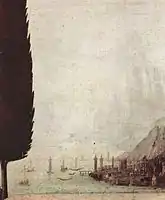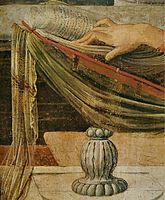| Annunciation | |
|---|---|
| Italian: Annunciazione | |
.jpg.webp) | |
| Artist | Leonardo da Vinci |
| Year | c. 1472–1476 |
| Medium | Oil and tempera on poplar panel |
| Subject | The Annunciation |
| Dimensions | 98 cm × 217 cm (39 in × 85 in) |
| Location | Uffizi, Florence |
The Annunciation is a painting widely attributed to the Italian Renaissance artist Leonardo da Vinci, dated to c. 1472–1476.[n 1] Leonardo's earliest extant major work, it was completed in Florence while he was an apprentice in the studio of Andrea del Verrocchio. The painting was made using oil and tempera on a large poplar panel and depicts the Annunciation, a popular biblical subject in 15th-century Florence. Since 1867 it has been housed in the Uffizi in Florence, the city where it was created. Though the work has been criticized for inaccuracies in its composition, it is among the best-known portrayals of the Annunciation in Christian art.
Description
The subject matter of the work is drawn from Luke 1.26–39. It depicts the angel Gabriel announcing to Mary that she would conceive miraculously and give birth to a son to be named Jesus and called "the Son of God", whose reign would never end. The subject of the annunciation was very popular for contemporaneous artworks painted in Christian countries such as Italy and had been depicted many times in Florentine art, including several examples by the Early Renaissance painter Fra Angelico. Details of the commission for the painting and its early history remain obscure.[1]
The marble table in front of Mary probably is derived from the tomb of Piero and Giovanni de' Medici in the Basilica of San Lorenzo, Florence, which Verrocchio had sculpted during this same period. The angel holds a Madonna lily, a symbol of Mary's virginity and of the city of Florence.
It is presumed that, being a keen observer of nature, Leonardo painted the wings of the angel to resemble those of a bird in flight, but later, the wings were lengthened dramatically by another artist.[2]
Although this is the earliest known commissioned painting by Leonardo, it has been pointed out that the painting already bears characteristics that are described as demonstrating the signature innovations he introduced in his paintings: sfumato and atmospheric perspective.[3]
Modern history
Following Gustav Waagen methods in 1869, Baron Liphart identified this Annunciation, that newly arrived in the Uffizi Gallery from the church of San Bartolomeo a Monte Oliveto in Florence, as by the young Leonardo while he still was working in the studio of his master, Andrea del Verrocchio.[4] Before that determination by Liphart the painting had been attributed to Domenico Ghirlandaio.
When the Annunciation came to the Uffizi in 1867, from the Olivetan monastery of San Bartolomeo near Florence,[5] it was ascribed to Domenico Ghirlandaio who, like Leonardo, was an apprentice in the workshop of Andrea del Verrocchio. In 1869, Karl Eduard von Liphart, the central figure of the German expatriate art colony in Florence, recognized the painting as a youthful work by Leonardo. It was one of the first attributions of a surviving work to the youthful Leonardo.[n 2] Since then, a Leonardo drawing in a collection at Christ Church Picture Gallery in Oxford was recognized as a preparatory drawing for the sleeve of the angel, further supporting the attribution to Leonardo.
Occasionally, some immaturity in Leonardo's painting technique is noted by art critics when discussing the spatial relationship between Mary and the desk and the marble table on which it rests.
Controversy
On March 12, 2007, the painting was at the center of a furor between Italian citizens and the Minister of Culture, who decided to loan the painting for an exhibition in Japan.[6][7]
Gallery
 Background
Background.jpg.webp)
.jpg.webp)
 Bible and the Virgin's hand
Bible and the Virgin's hand
See also
Notes
- ↑ Scholars date the painting to 1472–1476:
- Kemp (2019, p. 6): c. 1473–1474
- Marani (2003, p. 338): c. 1472–1475
- Syson et al. (2011, p. 15): c. 1472–1476
- Zöllner (2019, p. 216): c. 1473–1475
- ↑ Although there was hesitation on the part of some art historians who remarked on its Verrocchio-like qualities, and by Giovanni Morelli, who cited the angel's hands in assigning it to Ridolfo, son of Ghirlandaio, the attribution was accepted: David Alan Brown, Leonardo da Vinci: origins of a genius, 1998:169, 170.
References
- ↑ Uffizi, Leonardo da Vinci, Annunciation Archived 2014-08-08 at the Wayback Machine
- ↑ Wallace, Robert (1966). The World of Leonardo: 1452–1519. New York: Time-Life Books. p. 30.
- ↑ Ruggiero, Rocky, Florence: Uffizi Gallery – Leonardo da Vinci’s “Annunciation”, Rebuilding the Renaissance, Making Art And History Come To Life, May 26, 2021
- ↑ Brown, David Alan (1998). Leonardo da Vinci : origins of a genius. New Haven, Conn.: Yale University Press. p. 169. ISBN 0300072465.
- ↑ Uffizi: Florence. New York: Newsweek. 1968. p. 80.
- ↑ "NETZEITUNG KULTURNEWS: Da-Vinci-Gemälde lässt sich nicht anketten" (in German). Netzeitung.de. Archived from the original on 2012-02-13. Retrieved 2013-07-17.
- ↑ CBC Arts (12 March 2007). "Arts – Da Vinci work crated for loan despite Italian protests". Cbc.ca. Archived from the original on 13 November 2012. Retrieved 17 July 2013.
Sources
- Kemp, Martin (2019). Leonardo da Vinci: The 100 Milestones. New York: Sterling. ISBN 978-1-4549-304-26.
- Marani, Pietro C. (2003) [2000]. Leonardo da Vinci: The Complete Paintings. New York: Harry N. Abrams. ISBN 978-0-8109-3581-5.
- Syson, Luke; Keith, Larry; Galansino, Arturo; Mazzotta, Antoni; Nethersole, Scott; Rumberg, Per (2011). Leonardo da Vinci: Painter at the Court of Milan. London: National Gallery. ISBN 978-1-85709-491-6.
- Zöllner, Frank (2019) [2003]. Leonardo da Vinci: The Complete Paintings and Drawings (Anniversary ed.). Cologne: Taschen. ISBN 978-3-8365-7625-3.
External links
- Leonardo da Vinci: anatomical drawings from the Royal Library, Windsor Castle - the full The Metropolitan Museum of Art exhibition catalog that is online as a PDF contains material on Annunciation (see index)